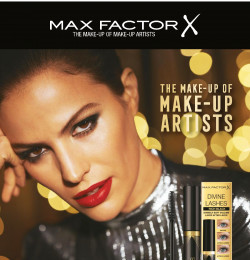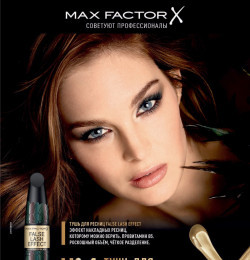Max Factor & Company is an international cosmetics firm, founded in 1909 by Max Factor, Sr., a Jewish-American make-up artist for the Russian royal ballet. He came from Łódź in Russian-Poland and was born in 1877. Factor emigrated to the United States in 1904 . He and his wife Lisa and three children travelled in the steerage class on board the S.S. Moltke and were processed at Ellis Island on February 25, 1904; he had $400 in his possession. Presently, the Max Factor name is a popularbrand of Procter & Gamble Co., which purchased the company in 1991. Max Factor died at the age of 59 in Beverly Hills, CA in August 1938.
In the 1920s and 1930s, the "golden years" of Hollywood, Max Factor became intimately associated with the world of movie make-up. He created the first makeup for the movies in 1914, and coined the term "makeup", based on the verb, "to make up" (one's face).
Max Factor's name appeared on many movie credits, and Factor himself appeared in some cameos. He created many looks to establish these actresses, such as Clara Bow's heart-shaped/pierrot lips. Years later, he exaggerated Joan Crawford's naturally full lips to distinguish her from the myriad of would-be stars copying the Clara Bow look he created. He also created shades specifically for them: Platinum (for Jean Harlow), Special Medium (for Joan Crawford), and Dark (for Claudette Colbert).
Max Factor & Company was a two-family, multi-generational, international cosmetics company before its sale in 1973 for $500 million dollars. Many of Max Factor's celebrity clients appeared, at no cost, in beautiful full page, color magazine ads to promote Max Factor cosmetics, so the brand "Max Factor" soon became world-renowned. Many famous actresses and celebutantes continue to use this quality make-up brand and some are paid spokepersons to promote it.
Max Factor is credited with many cosmetic innovations. Some of his innovations were the first motion picture makeup in 1914, Lip Gloss in 1930, Pan-Cake Makeup, forerunner of all modern cake makeups in 1937, Pan-Stik Makeup in 1948, Erace, the original cover-up cosmetic in 1954, and the first "waterproof" makeup in 1971.
After Max Factor's death in 1938, Frank Factor (Max Factor, Jr.) expanded the private cosmetics firm, along with members of the immediate family including Sidney Factor, Louis Factor, Davis Factor and Max Firestein. It was only decades later, by the 1960's Max Factor Jr., Max Firestein and grandsons Donald Factor,Alfred Jay Firestein and Chester Lee Firestein were still involved. Under his leadership, Max Factor, Jr. established a department store line "Geminesse" was a line of makeup, skincare and perfume products that bore the Max Factor name, but were only sold by uniformed clerks in deparment stores. It was launched sometime around 1965. The packaging and products were different; many of the containers were designed to resemble Grecian scupltures.
In 1973, after the untimely death of president Alfred Jay Firestein, Max Factor & Co. merged with Norton Simon Industries, and in 1976, president Chester Lee Firestein and Max Factor, Jr. resigned. They were the last members of Max Factor's immediate family to work for the company. It was under Norton Simon that Max Factor would launch "Maxi", a line of makeup aimed at a younger, more savvy consumer. Maxi sold products aimed at adolescent tastes, such as lip gloss, colour rubs and "mood" lipsticks. Maxi was priced to compete with market leaders Bonne Bell and Cover Girl.
Neither Maxi, Geminesse or Max Factor was able to lift the company's slagging profits and declining market share. However, in 1975, Max Factor launched the successful Halston line of fragrances, which quickly became the second best selling designer fragrance in the world. (Chanel No.5 was first).
In 1983, a company called Esmark took over Norton Simon; Esmark then merged with Beatrice Foods. Beatrice lumped Max Factor into their Playtex beauty division; in 1986, Ron Perelman of Revlon bought Playtex's beauty division for $500 million. However, by 1991, it had sold Max Factor to Procter and Gamble for $1.5 billion. As of 2007, Procter and Gamble still own the popular Max Factor brand.
Two of Max Factor's great-grandsons, Davis Factor, III and Dean Factor, founded Smashbox Studios in 1991. The enterprise expanded to incude a photo studio, modeling agency, production company, clothing line, and, in 1997, a cosmetics line called Smashbox Cosmetics. In 2004, Smashbox Cosmetics launched a global marketing campaign in conjunction with the legendary European cosmetics retailer Sephora. Another Max Factor descendent, Andrew Luster, is a serial rapist who's currently in prison serving a 126 year sentence for his 2003 conviction. Luster is the son of adopted Max Factor granddaughter Elizabeth Friedman-Luster.
The Max Factor Family continues their tradition of philanthrophy through various charitable organizations, trusts and private foundations. Grand children Gerald Factor, Max Factor III and Barbara Factor Bentley are trustees of the Max Factor Family Foundation which continues to make generous grants for medical research, patient health care, scholarships, human rights, care of the eldery, assistance to the disabled, etc.
Grand children Barbara Factor Bentley and Chester Lee Firestein serve on the Board of Directors of nationally acclaimed Cedars Sinai Medical Center in Los Angeles. The Factor-Firestein families have also contributed millions to CSMC, including construction of the Max Factor Family Tower and Alfred Jay Firestein Diabetes Center.
Michael Allen Firestein is a successful litigation attorney and partner with Proskauer Rose LLP in Los Angeles, CA. Community service is also an important part of Michael's personal life. Most significantly, for the more than 14 years, Michael has served as a member of the Board of Directors and the Executive Committee for Concern Foundation for Cancer Research, Inc. also serving as President of the Board of Directors from 1994-1996. Firestein also currently serves on the Board of Directors of Bet Tzedek, a Los Angeles based provider of vital pro bono legal services for the community.



